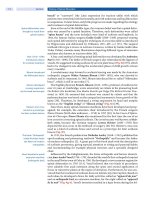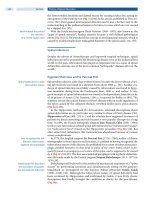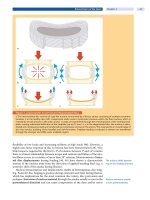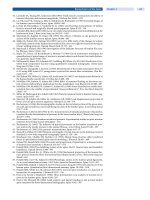Spinal Disorders: Fundamentals of Diagnosis and Treatment Part 24 ppsx
Bạn đang xem bản rút gọn của tài liệu. Xem và tải ngay bản đầy đủ của tài liệu tại đây (306.68 KB, 10 trang )
Function
Assessment of the back/neck related function of the patient is important because
many patients with spinal disorders are severely limited [35, 37]. However, Moo-
ney outlined that the definition of the terms impairment, disability and handicap
is not so straightforward and is often overlapping [23]. Physical impairment is
an anatomical, physiological, or psychological abnormality leading to loss of
normal bodily ability while disability is the resulting diminished capacity for
everyday activities and gainful employment or the limitation of a patient’s per-
formance compared to a fitperson of the same age and sex [23, 34]. Handicap can
be seen as a product of an interaction of a person with impairment and disability
and the environment [2] and thus resembles a loss or limitation of opportunities
to take part in community life on an equal level compared to healthy persons.
Functional limitations including activities of daily living should be assessed
with regard to:
sitting (time)
standing (time)
self-care
walking (distance, time)
sleeping (time)
weight lifting (maximum weight, position)
driving
reading
working above head/shoulder level
writing
working with computer
fine motor skills
sex life
social contacts (family, friends)
work status
Functional impairment
is best assessed with
a standardized questionnaire
The functional impairment should best be assessed using a standardized ques-
tionnaire [12, 27], which allows for an evaluation of the treatment outcome (see
Chapter
40 ).
Spinal Deformity
The assessment of spinal deformities requires some specific additional informa-
tion from the patient (or parents). The patients should be explored with respect to:
family history regarding spinal deformities
course of pregnancy
course of delivery
developmental milestones (onset of walking, speaking, etc.)
fine motor skills
tendency to fall (clumsiness)
onset of menses
growth of beard
growth spurt
breaking of the voice
evidence for metabolic or neuromuscular disorders
210 Section Patient Assessment
Physical Examination
In contrast to major joints of the extremities, which allow a passive examination
even in the presence of severe painful pathology, the physical assessment of the
spine is often hampered by strong muscle spasm. The patient with a spinal disor-
der is usually in pain and the examination often aggravates this pain. The physi-
The examination should
be done using a distinct
succession of body positions
cal examination should therefore be as short and effective as possible. In concor-
dance with Fairbank and Hall [13], we suggest analgorithm which does notfocus
on the classic examination approach (i.e. inspection, palpation, functional test-
ing) but on a succession of body positions which allow for a time-effective exami-
nation. The different examination positions consist of:
walking
standing
sitting
lying supine
lying on the left/right side
lying prone
The examination of the spine should include the whole spine and not only the
affected part(s) because the spine is an organ which extends from the occiput
down to the coccyx. Although as simple as it is obvious, it is important to stress
that patients should be examined undressed (down to their underwear). The
examination room should have enough space to allow free movement of the
patient and contain an examination table (
Table 5).
Walking
The physical assessment begins as soon as the patient enters the examination
room with an inspection of the gait. It is noted whether the patient is able to
walk unsupported or with support (e.g. by an accompanying person, crutches,
or wheelchair). After the completion of history taking, the patient is asked to
walk back and forth in the room. Any causes of limping must be differentiated,
i.e.:
pain
muscle insufficiency
Differentiate the
cause of limping
paralysis
ankylosis
leg length discrepancy
The patient should walk on their tiptoes (S1) and heels (L4, L5) to assess muscle
weakness in the lower limbs. Any evidence of atactic gait should be noted and
further explored (Rhomberg’s test, walking along a line; see Chapter
11 ).
Standing
Body height and weight should be assessed at least at the first clinical visit. For
follow-up examination of patients with spinal deformities the assessment of
body height (sitting and standing) is compulsory. The undressed patient should
be inspected for any presence of spinal stigmata such as caf´e-au-lait spots (neu-
rofibromatosis), hairy patches (spina bifida occulta), and foot size differences
(tethered cord). Any scarring must be noted and particular attention should be
paid to previous spinal or thoracic surgery (putative secondary spinal defor-
mity).
History and Physical Examination Chapter 8 211
Table 5. Physical examination algorithm
Walking
Inspection for:
limping (pain, muscle insufficiency, paresis, leg length discrepancy, ankylosis)
weakness while walking on tiptoes (S1) and heels (L4, L5)
difficulty walking along a line (atactic gait)
Standing
Assessment of :
body height and weight
Inspection for:
spinal stigmata
sagittal and coronal spinal balance
sagittal profile (hypo-/hyperkyphosis/lordosis)
muscle atrophies
level of shoulders
waist asymmetries and pelvic rotation
level of pelvis (in standing and flexed position)
rib/lumbar hump (in standing and flexion)
spinous process step-off
Functional testing of:
finger floor distance/Schober and Ott test
Trendelenburg test
left/right side bending and rotation
repetitive forward bending
repetitive backward bending and rotation
repetitive tiptoe standing (McNab’s test)
repetitive stool climbing
jumping on one leg
Sitting
Palpation of the cervical spine:
spinous processes, facet joints, transverse process of C2, mastoid
tender points in paraspinal muscle
Functional testing of cervical spine:
chin-sternum distance
active forward/backward bending, left/right side rotation (neutral position)
active left/right side rotation in flexion
active flexion/extension/side rotation against resistance
passive motion testing
Spurling’s test
Roos and Adson’s tests
Neurological assessment of:
sensory qualities (light touch, pin prick, proprioception)
muscle force (M0– 5)
muscle tendon reflexes
Lying supine
Assessment of :
muscle strength for foot extension, eversion, inversion and leg lifting
pathological reflexes (Babinski group, Trömner, Hofmann, and abdominal reflexes)
spasticity (arms/legs)
Lhermitte’s sign
straight leg raising test (Las`egue sign)
hip mobility
Patrick test, sacroiliac joint compression/distraction test
peripheral pulses
Lying on left/right side
Assessment of :
hip abduction force
Mennell’s test (sacroiliac joint)
perianal sensitivity and sphincter tonus
Lying prone
Palpation of:
spinous processes, paravertebral muscles, posterior superior iliac spine
femoral stretch test (reversed Las`egue sign)
212 Section Patient Assessment
In the standing position, the most important aspects to observe are:
coronal balance
sagittal balance
sagittal profile
muscle atrophies
Search for sagittal
and coronal imbalance
While the diagnosis of a coronal imbalance is easy to make with the plumbline
deviated off the intergluteal groove, the assessment of the sagittal profile is not as
obvious. A normal sagittal balance is present if the plumbline runs from the
external acoustic meatus down to the acromion, greater trochanter, lateral con-
dyle of the knee and the lateral malleolus. More difficult is the definition of the
sagittal profile because of the high individual variability [3]. A thoracic kyphosis
of 20–60 degrees is usually regarded as normal [3]. The definition of normal
lumbar or cervical lordosis is even more controversial. The normal range in the
literature for cervical lordosis (C2–7) ranges from 20 to 35 degrees [14]. How-
ever, Grob et al. [14] did not find a significant difference between patients with
neck pain compared to healthy individuals with regard to the global curvature,
the segmental angles, or the incidence of straight-spine or kyphotic deformity. In
a recent study, the lumbar lordosis of young adult volunteers ranged from 26 to
76 degrees with an average of 46 degrees [31]. The sagittal profile should be noted
Sagittal disbalance is a
frequent cause of back pain
but the sagittal balance is more important (Fig. 4). In particular, an anterior
imbalance can only be compensated poorly. The spinal muscles must counteract
this imbalance and thereby fatigue, which often results in severe pain. It isimpor-
tant to explore the sagittal imbalance in more detail and separate a global trunk
imbalance from a head protraction (anterior shifting of the cervical spine). The
anterior imbalance has a great impact because it increases the risk of progressive
A coronal dysbalance
can cause pain in idiopathic
scoliosis
thoracic kyphosis (e.g. in patients with multiple osteoporotic fractures). Simi-
larly, a severe double major scoliosis which is in balance is much less a clinical
problem than a decompensated moderate size thoracic curve.
Theimportanceofasystematicinspectionformuscle atrophies is self-evi-
dent. Furthermore, the presence of the following deformity relevant aspects
should be noted during inspection:
shoulder and pelvis level
pelvic rotation
thoracic asymmetry
waist asymmetry
rib and lumbar hump (during standing and forward flexion)
trunk shift (disc herniation)
spinous process step-off (spondylolisthesis)
In the forward flexed position, any asymmetries of the back contour and leg
length discrepancy become more obvious. Rib hump and lumbar hump should
be assessed either in millimeters or degrees. Leg length discrepancy with consec-
utive imbalance of the pelvis can be leveled with a wooden board of known
height under the foot of the shorter leg to determine the amount.
The finger-floor distance
is independent
of lumbar mobility
The finger floor distance is not a measure of the mobility of the lumbar spine
but of the hips and limited by the hamstring muscles. Tight hamstrings in an ado-
lescent with a recent onset of back pain may indicate a spondylolysis/spondylo-
listhesis.
Sagittal spinal range of
motion can be assessed
with the Schober and Ott
tests
The range of lumbar motion can be assessed during forward flexion with the
so-called Schober test. A skin mark is made over the spinous process of S1 and
10 cm above. A normal lumbar range is present when the distance between the
upper and lower skin mark increases from 10 to over 15 cm (documented as 10/
15 cm) during forward flexion. The Ott test or thoracic Schober test is an equiva-
History and Physical Examination Chapter 8 213
ab
Figure 4. Coronal and sagittal balance
a In the coronal plane the gravity line should fall in the rima ani and between both feet. b In the sagittal plane the gravity
originating from the external auditory canal should run along the acromion, greater trochanter, lateral knee condyle and
lateral malleolus.
lent test for thoracic spine mobility. A skin mark is made at the spinous process
of C7 and a second mark 30 cm below. The distance should range up to 38 cm
(documented as 30/38 cm). However, both reproducibility and diagnostic value
remain debatable. An important observation is to document an abnormal spinal
motion pattern when the patient becomes erect from the forward flexed position.
Some patients need the support of their hands on the thigh to straighten up
again. This may indicate an underlying segmental instability.
The motion of the lumbar spine is best tested with hands crossed behind the
neck (
Fig. 5). The following movements should be tested:
side bending
side rotation
backward bending
backward bending with rotation
Repetitive motions
can provoke
typical symptoms
A precise and reproducible assessment is not possible. Therefore, we prefer to
semiquantitatively estimate how much these movements are limited (reduced by
a quarter, half, etc.). More important than the range of motion is the provocation
of symptoms. Side rotation and backward bending stresses more the facet joints,
214 Section Patient Assessment
abc
def
g
i
h
Figure 5. Physical assessments
a Lumbar spine: a left/right side rotation; b left/right side bending; c backward bending. Cervical spine: d left/right side
rotation;
e left/right side bending; f backward bending. g Patrick test; h Mennel test; i Las`egue test
History and Physical Examination Chapter 8 215
while side and forward bending stresses more the intervertebral discs. Pain prov-
ocation during these movements may therefore be indicative of an underlying
pathology of these structures. Repetitive tests may be useful in this context. In
patients with disc herniation, side rotation and backward bending is likely to
increase the pain because this test narrows the lumbar foramen.
Repetitive testing
may disclose a subtle
muscle weakness
A global functional test of the motor force of the lower extremities is applied
when the patient is asked to jump on one leg. This ability excludes a relevant
paresis of the lower extremities because all muscle groups are activated. Patients
frequently present with only subtle motor weakness, which is often not detected
Repetitive tiptoe standing
can reveal a subtle
weakness
during routine examination. A subtle weakness of the gastrocnemius muscle (S1)
canbedetectedbystandingononelegwithrepetitive(e.g.10timesoneachside)
tiptoe standing (McNab’s test). A similar test for the quadriceps muscle (L3–4) is
repetitive stool climbing. A subtle weakness will present with an earlier fatigue.
Sitting
The cervical spine is best examined when the patient is sitting on an examination
table with their lower limbs and feet freely moving. In contrast to the lumbar
spine, palpation of bony landmarks is easier in the cervical spine. The examiner
should palpate:
spinous processes C2–7
transverse process of C1
mastoid process
facet joints
Always palpate where it is
most painful mainly for psy-
chological reasons
Thepalpationoftheparavertebralmusclesorosseousprocessusisseldomof
diagnostic value but reasonable from a psychological point of view. If the exam-
iner does not palpatethe often painful musclesandprovoke pain,thepatient may
get the impression that they are not being thoroughly examined. Palpation must
include the supraclavicular fossae (enlarged lymph nodes, tumor, cervical rib)
and the anterior structures (including the thyroid gland).
Functional testing of the cervical spine begins with the measurement of the
chin sternum distance. This measure is useful to document the clinical course but
not so much as an objective parameter.The assessmen t of the mobility of the cer-
vical spine consists of:
flexion/extension (chin-sternum distance: documentation, e.g. 2/18 cm)
left/right rotation (normal: 60°–0–60°) in neutral position
left/right rotation (normal: 30°–0–30°) in flexed position
left/right rotation (normal: 40°–0–40°) in extended position
left/side bedding (normal: 40°–0–40°)
Cervical spine motion is
examined with active and
passive motion and against
resistance
In flexion, rotation only occurs at the upper cervical spine because the facet joints
of the lower cervical spine are flexed and there the facet joint capsules are
stretched resisting rotation. In extension the upper cervical spine joints are
blocked only permitting rotation in the lower cervical spine. Differences in pain
provocation in the flexed and extended position may indicate the level of pathol-
ogy. In the case of limitation of active movements, the examination is repeated
with passive motion to differentiate between a soft (muscle, pain) and a hard
(bony) stop. Beside the assessment of the motion, the provocation of pain is rec-
ommended. This can be enhanced by examining the cervical spine against resis-
tance and stresses the intervertebral discs (flexion, side bending) or facet joints
(rotation, extension), respectively.
If a cervical radiculopathy is suspected, the following tests can be carried out
to provoke the patients’ radicular symptoms (
Fig. 6):
216 Section Patient Assessment
ab
cd
Figure 6. Provocation tests for cervical radicular pain
a Spurling’s test: continuous (30 –60 s) pressure is applied in different head positions (left/right side bending or rotation in
neutral position, flexion and extension).
b Depending on the target level the different rotation positions further narrow the
spinal foramen and may elicit typical radicular pain.
c Valsalva maneuver: this test may elicit pain by increasing the intradu-
ral pressure.
d Shoulder depression test: this test stretches an affected nerve root and may cause radicular arm pain.
Spurling’s test
Valsalva maneuver
shoulder depression test
Consider thoracic outlet
syndrome in the case
of arm pain
In the case of a potential differential diagnosis of thoracic outlet syndrome,
Adson’s and the Roos tests can be carried out. Adson’s test consists of hyperex-
tending the neck and turning the head to the affected side while holding breath.
The maneuver leads to a decrease of theradial pulse and tingling in the hand. The
Roos test is carried out with both arms 90 degrees abducted and externally
History and Physical Examination Chapter 8 217
rotated. The individual rapidly opens and closes the hand for 3 min. The test is
positive if the hand becomes pale or blue and the maneuver provokes the typical
symptoms.
A thorough neurological
examination is compulsory
The neurological assessment can be best performed with the patient either in
the supine or the seated position. We prefer the latter position because it allows
for a better testing of muscle force (e.g. shoulder abduction, hip flexion, knee
extension). A prerequisite for a thorough neurological assessment is a profound
knowledge of the dermatomal (
Fig. 1) and peripheral (Fig. 2)skininnervation.
Multiple sensory qualities (heat–cold, pain, touch, pressure, static and dynamic
two-point discrimination, vibration sensation) can be distinguished. The most
important examinations are:
light touch
pin prick
proprioception
Light touch can still be preserved in the presence of nerve root compression
when pin prick is already decreased (see Chapter
11 ). The cross-over innerva-
tion for pain is much less pronounced than for the sensory quality of light touch.
The assessment of proprioception (vibration) is important in the differential
diagnosis of radiculopathy and peripheral neuropathy. Each dermatome must be
systematically assessed in order to allow for a differential diagnosis of a radicular
vs. a peripheral neuropathy.
The assessment of each key muscle and tendon reflex (
Table 6
)caneasilybe
done in the seated position. A differential diagnosis of peripheral nerve palsies
is necessary and diagnosis can be done clinically in many cases (
Fig. 7
). How-
ever, the differential diagnosis can sometimes be very difficult and require
Table 6. Motor innervation and muscle tendon reflexes
Nerve
root
Muscle Reflex Differential diagnosis for peripheral neuropathy
C3/4 diaphragm deltoid reflex (inconsistent) phrenic nerve (tumor)
deltoid muscle
C5 deltoid muscle, biceps muscle biceps reflex axillary nerve
musculocutaneous nerve (normal innervation of
the brachioradialis muscle, normal sensation of
the thumb)
C6 biceps muscle extensor carpi
muscle
biceps reflex, brachioradial
reflex
musculocutaneous nerve
radial nerve
C7 triceps, wrist flexors, finger
extensors
triceps reflex median nerve (carpal tunnel syndrome, disturbed
sweat secretion)
C8 abductor digiti minimi muscle – ulnar nerve (sharp sensory deficit of the ulnar half
of the ring finger)
interossei muscles
L2 iliopsoas muscle (hip flexion) adductor reflex (inconsistent) obturator nerve
L3 quadriceps muscle patellar tendon reflex lateral cutaneous nerve (meralgia paresthetica –
normal motor function)
L4 tibialis anterior patellar tendon reflex femoral nerve (intact innervation of the saphe-
nous nerve)
L5 extensor hallucis longus mus-
cle, gluteus medial muscle
tibialis posterior reflex
(inconsistent)
peroneal nerve (intact hip abduction)
S1
peroneus brevis, triceps muscle
Achilles tibial nerve (extensor hallucis longus weakness)
218 Section Patient Assessment
abc
def
Figure 7. Peripheral nerve palsies
a, b Radial nerve palsy : The patient is unable to extend a his wrist and b fingers in the metacarpophalangeal joints.
c Median nerve palsy: inability to close the hand to a fist to firmly grip a bottle and d to oppose the thumb and fingertips.
e Ulnar nerve palsy: hyperextension of the metacarpophalangeal joints of the ring and little finger indicates a paralysis
of the intrinsic muscles and
f inability to adduct the thumb without flexion of the interphalangeal joints (Froment’s sign).
Note the autonomic regions of innervation for the respective nerves (darker color).
Table 7. Clinical motor strength grading
Motor grade Findings
5 full movement against full resistance
4 full movement against reduced resistance
3 full movement against gravity alone
2 full movement only if gravity eliminated
1 evidence of muscular contractions or fasciculations
0 no contractions or fasciculations
detailed neurological assessments and neurophysiological studies for further
differentiation (see Chapters
11 , 12 ). The muscle force should be assessed
according to a standardized protocol either following the guidelines of the Brit-
ish Medical Research Council (
Table 7
) or as modified by the ASIA Standards
(see Chapter
11 ).
History and Physical Examination Chapter 8 219









